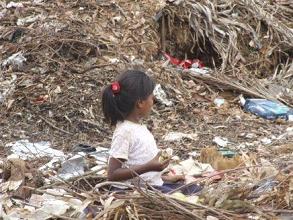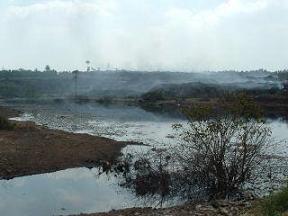Mavallipura Dumping Sites
Current
The dump at Mavallipura
About 20 kms north of Bangalore city, close to Yelahanka town and the Yelahanka Air Force Base, there is a village called Mavallipura. With the tacit approval of Bangalore Mahanagara Palike (BMP), every day since May 2003, about 200 truckloads of municipal solid waste from some of the northern wards of Bangalore are being dumped on 20 acres of land belonging to one Mr. Bylappa from Mavallipura. On average, each truckload of waste weighs about 2.5 to 3 tons. The leachate from the dump is allowed to stagnate in a ditch next to the dump and slowly finds its way into surface and ground water aquifers. Over the years all drinking water sources in the vicinity have been adversely affected, and the threat looms large of contaminating the Arkavathy river, a major drinking water source of Bangalore. It is in this river basin that the Mavallipura dump is located.
Note that a dump is different from a landfill in the way the waste is disposed off. A landfill is a constructed by digging out the earth to form a very large ditch which is provided with an impermeable lining and a leachate collection system to prevent ground water contamination. An outlet for gases formed during decomposition is also provided. A dump in contrast does not have any of these provisions and therefore causes serious air, soil and water pollution.
Leachate pond next to the Mavallipura dump
In Mavallipura, the dumping is carried out next to a forest area and a Eucalyptus plantation. Adjoining the dumping site is agricultural land where crops like ragi (finger millet), avarekaalu (field beans) and flowers are cultivated. Dogs, cattle, cats, crows are some of the animals seen in the vicinity of this area. Vultures are recent additions to the bird population of this area. Additionally, in the vicinity of Mavallipura, there are a few tanks (which are large surface water bodies created to harvest rain in an interlinked pattern) which are part of a chain of lakes/tanks that join the Arkavathy river. Two of these tanks, the Mavallipura Tank and the Koramana Kunte tank, are downstream from the waste dump and hence are polluted by the leaching of pollutants and toxic material from the dump.
As can be expected, this open dumping (and burning) of garbage has resulted in serious environmental pollution including contamination of water bodies here. The villagers of Mavallipura rely on groundwater in this area for their drinking water and cooking needs and face serious health consequences.
ESG has developed a report on the analysis of the water quality in this area (based on water samples taken here), and the health hazards posed by the contaminants present in this water. The principle objective of water quality testing undertaken by us is to examine if there has been a contamination of groundwater sources due to the all the waste that is being continuously dumped on Bylappa�s land.
This examination is necessary because the villagers use water from underground reservoirs for drinking and the contamination of these sources could pose a health hazard. The water quality test gives an estimate of the level of contamination in the ground water sources of drinking water and this is useful in assessing the risk of health hazard to the villagers of Mavallipura.
ESG is an independent not-for-profit organisation that promotes the cause of environmental and social justice through research, documentation, advocacy, training and campaign support. We aim to support the rights of local communities and voiceless ecosystems in a responsible, progressive manner that keeps contextual complexities in mind.


